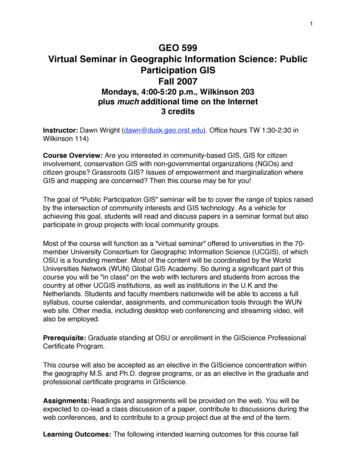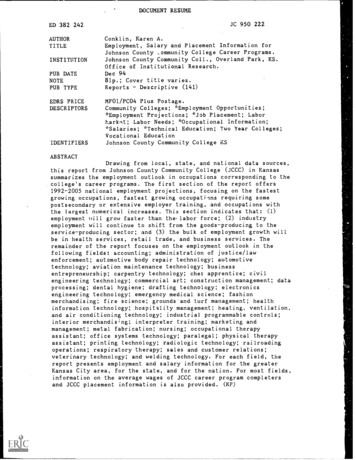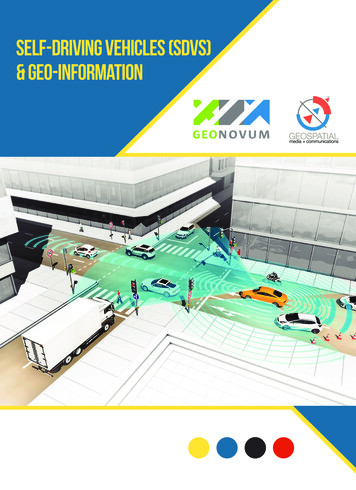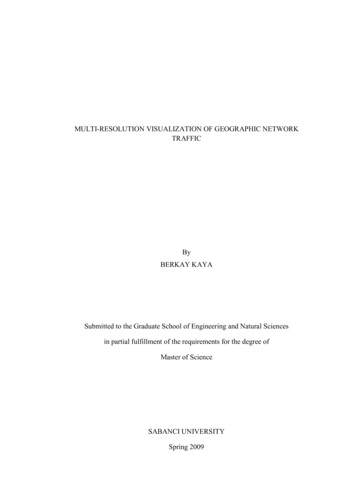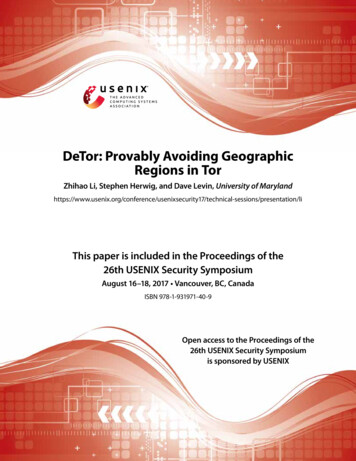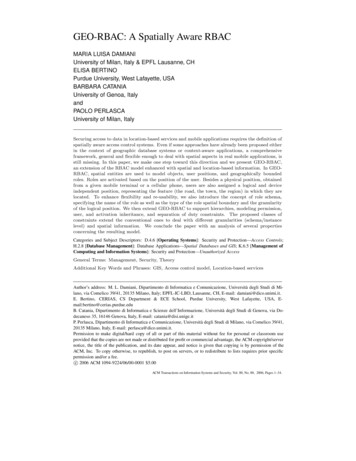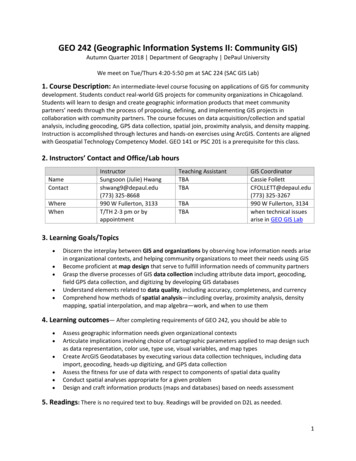
Transcription
GEO 242 (Geographic Information Systems II: Community GIS)Autumn Quarter 2018 Department of Geography DePaul UniversityWe meet on Tue/Thurs 4:20-5:50 pm at SAC 224 (SAC GIS Lab)1. Course Description: An intermediate-level course focusing on applications of GIS for communitydevelopment. Students conduct real-world GIS projects for community organizations in Chicagoland.Students will learn to design and create geographic information products that meet communitypartners’ needs through the process of proposing, defining, and implementing GIS projects incollaboration with community partners. The course focuses on data acquisition/collection and spatialanalysis, including geocoding, GPS data collection, spatial join, proximity analysis, and density mapping.Instruction is accomplished through lectures and hands-on exercises using ArcGIS. Contents are alignedwith Geospatial Technology Competency Model. GEO 141 or PSC 201 is a prerequisite for this class.2. Instructors’ Contact and Office/Lab hoursNameContactWhereWhenInstructorSungsoon (Julie) Hwangshwang9@depaul.edu(773) 325-8668990 W Fullerton, 3133T/TH 2-3 pm or byappointmentTeaching AssistantTBATBATBATBAGIS CoordinatorCassie FollettCFOLLETT@depaul.edu(773) 325-3267990 W Fullerton, 3134when technical issuesarise in GEO GIS Lab3. Learning Goals/Topics Discern the interplay between GIS and organizations by observing how information needs arisein organizational contexts, and helping community organizations to meet their needs using GISBecome proficient at map design that serve to fulfill information needs of community partnersGrasp the diverse processes of GIS data collection including attribute data import, geocoding,field GPS data collection, and digitizing by developing GIS databasesUnderstand elements related to data quality, including accuracy, completeness, and currencyComprehend how methods of spatial analysis—including overlay, proximity analysis, densitymapping, spatial interpolation, and map algebra—work, and when to use them4. Learning outcomes— After completing requirements of GEO 242, you should be able to Assess geographic information needs given organizational contextsArticulate implications involving choice of cartographic parameters applied to map design suchas data representation, color use, type use, visual variables, and map typesCreate ArcGIS Geodatabases by executing various data collection techniques, including dataimport, geocoding, heads-up digitizing, and GPS data collectionAssess the fitness for use of data with respect to components of spatial data qualityConduct spatial analyses appropriate for a given problemDesign and craft information products (maps and databases) based on needs assessment5. Readings: There is no required text to buy. Readings will be provided on D2L as needed.1
6. Course Outlines and Tentative Schedules*WkDateTopicIn-class activities109.06Course overview09.11GIS I recap: cartography, database,coordinate systemsData classification and normalizationfor thematic mapping, color/type useCodd’s normalization, geocoding,census, geodatabaseTypology of GIS data collection,digitizing, coordinate transformationCommunity partners (CP) talkabout their org. and projectsEx0. race and income in Chicago?209.1309.18309.20409.2509.27GPS, data 310.2510.30CITI Certification Training (no class)CITI Certification Training (no class)Proximity analysis, overlay, spatialjoinDensity mapping, spatialinterpolation, map algebraWeb mappingEx2. create a geodatabase fromstreet addresses and census dataEx3. create a geodatabase by OSMdata import (QGIS) and editingWork on P1 as a groupEx4. GPS field data collectionTasks done in & out ofclassP1. Form a group andarrange to meet with CPP1. Needs assessmentmeeting with CPP1. Needs assessmentmeeting with CPP1. Conduct backgroundresearchP1. Conduct backgroundresearchHW1 due (4:20p)P1 due (4:20p)CP visit to provide input for P1 andP2P1. Seek feedbackP2. List data needsEx1. map population changeEx5. Near, spatial join, Thiessenpolygon, centroid toolsEx6. Kernel density, IDW, rastercalculator, zonal statistics toolsEx7. create a web map appWork on P2 as a groupWork on P2 as a groupWork on P3 as a group11.01Work on P3 as a group11.0611.0811.1311.15Work on P4, P5 as a groupWork on P4, P5 as a groupCP visit for group presentationPresentation (P4)Final exam (take-home) due 11:59pCITI Cert. due (11:59p)HW2 due (4:20p)P2. Acquire/create dataP2. Acquire/create dataP2. Process/clean dataP2. Assess data qualityHW3 due (4:20p)P2 due (4:20p)P3. Identify GIS functions.P3. Create and presentinfo. product for feedbackP3 due (4:20p)P4, P5 due (4:20p)Project milestonesP1. Needs assessment: state context, motivation, and goals of the project in conjunction with your CPP2. Data acquisition: describe what data you acquired and how you created data needed for projectP3. Data analysis & visualization: describe how you created information products (maps and database)P4. Presentation – present goals, data, methods, results, and conclusions in front of your CPP5. Final report and information products (IP) – submit final report and IP (e.g., map package files)*Topics and schedules are subject to change depending on how the class progresses2
7. Grading SchemeComponentsParticipationBreakdown(/100 points)10ExercisesCITI CertificationHomeworkProjectFinal exam216123615Additional informationEffort typeBased on attendance, class participation,and group discussion7 exercises. Each is worth 3 pointsdue in Week 5B 11:59 pm3 homework. Each is worth 4 pointsP1-P4 4 points, P5 20 pointsTake-home exam during an exam weekIndividual effortGroup effortIndividual effortIndividual effortGroup effortIndividual effortParticipation: assigned according to the criteria below 9-10 Student is present in all or nearly class meetings, and prepared, at all times, to respond toquestions. Student is an active participant in small group activities, in and out of class, and in classtime activities stays on task. 8-9 Student participates as above, 75% of the time. 6-7 Student does not volunteer comments; responses demonstrate vague familiarity with coursereadings. Student is a passive member of small group activities and/or does not stay on task duringclass-time activities. 5-6 Student never volunteers, cannot respond to direct questions, keeps silent during classdiscussions and is unable to summarize readings if asked. 0-5 Student misses many class sessions and/or sits silently in classes when present, or is disruptiveand non-participatory in the classroom.Group Exercises: learn how to use ArcGIS, and submit answers to questions while performing GIS tasks.You can work on performing GIS tasks alone, but answers to questions should be submitted as a groupwork after discussion. Exercises will be completed in class when instructors are present under mostcircumstances.Although reasonable amount of time is given to complete exercises in the class, it is expected that youas a group will complete remaining part of activities outside of the class if you can’t complete activitiesin the class while most of other groups completed activities in time. Exercises can be submitted on thedate exercises are handed out or before the next class. Exercise questions will be discussed together inthe next class.Homework: solve problems that are similar to group exercises on your own. HW1 (geodatabase) isdrawn from Ex1 and Ex2. HW2 (data capture) is drawn from Ex3 and Ex4. HW3 (spatial analysis) is drawnfrom Ex 5 and Ex6. Homework should be submitted on D2L individually.Project: A group of three persons will work together throughout the quarter in and outside of theclassroom to achieve goals that groups set out in conjunction with community partners. Project consistsof five milestones: P1 (needs assessment), P2 (data acquisition), P3 (data analysis and visualization), P4(presentation), and P5 (final report).Although a few hours will be set aside for each milestone in the class (see the class schedule above), it isexpected that you will spend 4-6 hours a week for project outside of the class on completing projectmilestones in coordination with your group members and community partner throughout the quarter.3
For instance, you would need to spend several hours to do the following outside of the class: Conduct needs assessment meeting with your CP during week 1-2 for P1Conduct background research during week 2-3 for P1Identify data requirements and seek feedback from community partner during week 4 for P2Acquire or create data in coordination with your CP during week 6 for P2Clean up data and explore data for assessing data quality during week 7 for P2Create information products (maps and databases) during Week 8 - 9 for P3Prepare presentation and write up final report during week 9 - 10 for P4 and P5Final exam: an open-book comprehensive written test will be taken during an exam week. You willreceive a test via email on the date scheduled for a final exam at 9 am, and should submit answers toquestions on D2L by 11:59 PM on that date.Grading scale: A 93-100%; A- 90-92.99%; B 87-89.99%; B 83-86.99%; B- 80-82.99%; C 7779.99%; C 73-76.99%; C- 70-72.99%; D 60-69.99%; D 50-59.99%; F 0-49.99%Late Work Policy: Late work will NOT be accepted. Extensions can be requested if needed, but will beonly granted under understandable circumstances (e.g., clients did not provide data in time; you had tobe in a funeral).Makeup Exam/Incomplete Grade Policy: A makeup exam or an incomplete grade can be arranged orgranted only when credible dire and documented medical or family situations arise and thesecircumstances are communicated in a timely fashion.8. Access to ArcGISLabs with ArcGIS for Desktop: SAC GIS lab (SAC 224), SAC 268, 990 GIS lab (990 W Fullerton, Room#3135), Richardson Library, Loop Library, Daley 1327GIS lab open hours Geography GIS Lab (990 W Fullerton, Room# -lab.aspx or the lab door. SAC GIS lab (SAC 224): http://qrc.depaul.edu/hours.htm or the lab door.Install ArcGIS in your Windows personal computer: ArcGIS is ONLY supported in Windows computer. Ifyou’re enrolled in GIS classes at DePaul University with an ESRI site license, you will receive a digitalstudent license via email. If you have an Apple computer, use DePaul Virtual Lab.To access ArcGIS in both PC and Mac remotely: go to DePaul Virtual Lab http://vlab.depaul.edu. Qualityof user experiences vary by internet speed. At least 8 Mbps is recommended. If you have an issue withusing Virtual Lab, contact a GIS coordinator.9. MiscellaneousAttendance/Absentee Policy: Consistent with university’s policy, all students are expected to attendclass meetings. Unless absence is explained on medical or compassionate grounds (documentation isrequired), absence from any classes is grounds for a grade adjustment.4
Academic Honesty and Plagiarism: Academic honesty and integrity are expected at all times. Academicdishonesty, such as cheating or copying during exams, will be punished severely. Plagiarism – usingsomeone else’s work without acknowledgment and, therefore, presenting their ideas or quotations asyour own work – is strictly forbidden. DePaul University officials will be informed of any instance ofacademic dishonesty and notification will be placed in your file. Please read the DePaul AcademicIntegrity Resources page ex.html) for definitionsand explanations of plagiarism and the University’s Academic Integrity expectations for students.Cutting and pasting text taken directly from a web-site without appropriate referencing and quotationmarks is plagiarism and is forbidden. Submitting work that has any part cut and pasted directly from theinternet is grounds for an automatic grade of zero.Accommodations: Any student who requires assistance is asked to contact the University’s Center forStudents with Disabilities (CSD) (Phone 773/325-1677, TTY 773/325-7296, Fax entswithdisabilities).They will be able to assist both student andfaculty. If you have a condition that requires accommodation from the Productive Learning Strategiesprogram (PLuS Program) please contact them at the Student Center room 370 (Phone 773/3251677 oronline: http://studentaffairs.depaul.edu/plus/University Center for Writing-Based Learning: Collaborates with writers from all disciplines,backgrounds, levels of expertise, and roles within the University community. Their goal is to helpdevelop better writers along with better writing and reflection through continual revision. If you needassistance with writing assignments, they can be contacted at: 773.325.4272 (LPC) orwcenter@depaul.eduHarvard Referencing Style(a) Reference Lists: Reference lists must be in alphabetical order by author’s last name. Items by thesame author must be in chronological order. Indent all but the first line of the citation. Please use thefollowing style: When referencing a direct quotation:Knox and Pinch (2000: p.172) argue that “social polarization has been taking place.”When referencing an idea: According to Knox and Pinch (2000), there has been social polarization.(b) Books: Knox, Paul and Steven Pinch. 2000. Urban Social Geography: An Introduction.4thed.Englewood Cliffs, NJ: Prentice Hall.(c) Book chapters in an edited collection: Beauregard, Robert A. 1986. The Chaos and Complexity ofGentrification. In Smith, Neil and Peter Williams, eds. Gentrification in the City. Boston: Allen and Unwin:35-45.(d) Journal articles: Borchert, John R. 1967. American Metropolitan Evolution. The Geographical Review57(3): 301-332.(e) Internet articles: Gray, Geoffrey. 2003. Bad for Business: Budget Cuts Threaten Small Manufacturers.City Limits Weekly #411. www.citylimits.org. Accessed May 5, 2008.10. Department of Geography Learning Goals—GEO 242 addresses 1), 5), 6), and 7).Courses in the Department of Geography teach students:1) Understand spatial patterns and processes of modification of the Earth’s physical and culturallandscapesa. As social constructions.b. As systems that link the Earth with human society in interdependent, dialecticalrelationships, and5
c. Through mapping and visualization.2) Understand the concept of scale as a spatial phenomenon that ties the local, the regional, thenational, the transnational, and the global in a system of interaction.3) Understand the phenomenology of the discipline of Geography—most importantly, “space”,"place", "landscape," "region," and "location".4) Distinguish that spaces, places, and so on, may have both objective and subjective/symbolicdimensions.5) Develop research and writing competences that would allow you to:a. Formulate a cogent research question about the spatial character of a physical, sociocultural, or environment-societal phenomenon,b. Write about it in ways that reflect analytical and critical thinking, andc. Ethical concern over social and environmental justice, consistent with the University’ssocial mission.6) Engage competently in qualitative and quantitative spatial analysis, and with exercises thatare concerned with explaining spatial regularities (for example, the spatial calculus behind thelocation of retail commerce in Chicago, or transnational flows of capital).7) Learn the basic utility and use competently one or more of the information technologies thatare now redefining the logistical limits of spatial analysis: geographic information systems(GIS) and remote sensing.8) Achieve greater general knowledge of the world, its regions, its physical systems, its cultures,and political-territorial divisions.6
Appendix A: Community Partners and Project DescriptionThe Coalition for Immigrant Mental Health (CIMH)CBO Mission StatementThe CIMH mission aims to foster a collaborative, community-based and researchinformed initiative that is a partnership between individuals regardless of status, mentalhealth practitioners, community organizers, researchers, and allies. As such, CIMH worksto promote awareness of and access to culturally and linguistically appropriate mentalhealth services through education, advocacy and resource sharing in order to improveand facilitate access to services for immigrants and their families regardless of theirstatus.CBO Websitewww.Cimhil.orgCBO Contact InformationPrimary Contact Name:Primary Contact Email:Primary Contact Phone:Maria Ferreramferrera@depaul.edu312.362.7382Cell: 773.879.0057Secondary Contact Name:Secondary Contact Email:Secondary Contact Phone:Virginia Project DetailsIdentified as one of its action areas, The Coalition works to promote awareness of and access toculturally and linguistically appropriate mental health services through education, advocacy andresource sharing in order to improve and facilitate access to services for immigrants and refugees. Aspart of its efforts, CIMH has developed a directory of mental health services available to immigrants,community organizations and practitioners across the metropolitan area. We continue to expand thisdirectory to include community- based organizations throughout Illinois and neighboring cities/states.It would be helpful if we can provide a visual map to these locations that provide mental healthservices. The directory can be found here: https://cimhil.org/resources/mh-directory/.In addition to the mapping of these locales, it would be helpful to understand the map in the context ofwhere most immigrants/undocumented immigrants live and get a sense of geographic areas wheremental health services seem to be lacking. CIMH core leadership team can further discuss other areasof information that would be helpful with regard to a GIS mapping project.7
Community-based Organization (CBO) NameCommunity Activism Law Alliance (CALA)CBO Mission StatementCALA unites lawyers and activists in a collaborative pursuit for justice by leveraging legal services tobenefit the most marginalized communities and individuals. CALA is changing legal aid. We are changinghow lawyers and communities work together. Our lawyers work with activists to help their communitiesaccess justice and pursue social change.CBO Websitehttp://www.calachicago.org/CBO Contact InformationPrimary Contact Name:Primary Contact Email:Primary Contact Phone:Saul Brand Padillasaul@calachicago.org312-999-0056Secondary Contact Name:Secondary Contact Email:Secondary Contact Phone:Alejandra Floresalejandra@calachicago.orgNAProject DetailsCALA has a unique lawyering model; therefore, we started some research to find out if there are otherLegal Aid organizations around the nation that have the same or similar model to us. Our goal is tocreate an interactive map (GIS) to be used as a tool for community members/activist all around the USto help them locate Legal Aid organizations near them. CALA has the initial data for this project: Nameof the organization ranked by accuracy in our model, state, and the email draft that can be used toreach out to those organizations.8
Community-based Organization (CBO) NameDream On EducationCBO Mission StatementOur mission is to prepare high-performing, low-income 6th-8th grade students for the rigor of a highschool and college curriculum and challenge them beyond their comfort level, which will enable themto maximize their potential, reach their dreams, and contribute positively to society.CBO Websitewww.dreamoneducation.orgCBO Contact InformationPrimary Contact Name:Primary Contact Email:Primary Contact Phone:Kelli 880Secondary Contact Name:Secondary Contact Email:Secondary ContactPhone:Tom PerrosTom.Perros@espglobal.comProject DetailsDream On Education provides services to high-achieving low-income students in the Greater ChicagoArea. This demographic is often the "
GEO 242 (Geographic Information Systems II: Community GIS) Autumn Quarter 2018 Department of Geography DePaul University We meet on Tue/Thurs 4:20-5:50 pm at SAC 224 (SAC GIS Lab) 1. Cours
